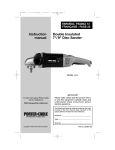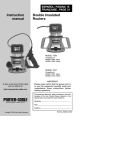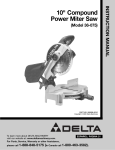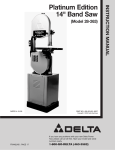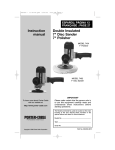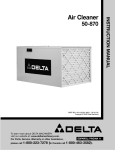Download RIDGID Dry Cut Saw Instruction manual
Transcript
ESPAÑOL: PAGINA 11 FRANÇAISE : PAGE 23 Instruction Manual 14" “Dry-Cut” Metal Cutting Saw MODEL 1410 To learn more about Porter-Cable visit our website at: http://www.porter-cable.com IMPORTANT Please make certain that the person who is to use this equipment carefully reads and understands these instructions before starting operations. The Model and Serial No. plate is located on the main housing of the tool. Record these numbers in the spaces below and retain for future reference. Model No. _____________________________________ Type __________________________________________ Serial No.______________________________________ Copyright © 2000 Porter-Cable Corporation Part No. 896182-009 SAFETY INSTRUCTIONS GROUNDING INSTRUCTIONS GROUNDED OUTLET BOX WARNING: THIS TOOL SHOULD BE GROUNDED WHILE IN USE TO PROTECT THE OPERATOR FROM ELECTRIC SHOCK. The tool is equipped with an approved three-conductor cord and three-prong grounding type plug to fit the proper grounding type receptacle. The green (or green and yellow) conductor in the cord is the grounding wire. Never connect the green (or green and yellow) wire to a live terminal. CURRENT CARRYING PRONGS GROUNDING PRONG IS LONGEST OF THE 3 PRONGS If your unit is for use on less than 150 Volts, the power cord is equipped with a plug that has two flat, parallel current-carrying prongs and one longer, round or “U”-shaped, ground prong which requires a mating 3-conductor grounded type receptacle, as shown in Fig. 1. Fig. 1 GROUNDED OUTLET BOX GROUNDING MEANS ADAPTER An adapter, shown in Fig. 2, is available for connecting 3-prong grounding type plugs that are used on units less than 150 Volts to 2-prong receptacles. THIS ADAPTER IS NOT ALLOWED IN CANADA. The green colored rigid ear, lug, etc., must be connected to a permanent ground such as a properly grounded outlet box, as shown in Fig. 2. Fig. 2 If your unit is for use on 150 to 250 Volts, the power cord is equipped with a plug that has two flat current carrying prongs in tandem, and one round or “U”-shaped, longer ground prong, as shown in Fig. 3. This plug is used only with the proper mating 3-conductor grounding type receptacle, as shown in Fig. 3. No adapter is available for this type plug. GROUNDED OUTLET BOX CURRENT CARRYING PRONGS WARNING: IN ALL CASES, MAKE SURE THE RECEPTACLE IN QUESTION IS PROPERLY GROUNDED. NEVER REMOVE GROUNDING PRONG FROM POWER PLUG. GROUNDING PRONG IS LONGEST OF THE 3 PRONGS Fig. 3 EXTENSION CORDS Use only three-wire extension cords which have three-prong grounding type plugs and three-pole receptacle which accept the tool’s plug. Replace damaged or worn cord immediately. DO NOT ATTEMPT TO REPAIR POWER CORD. 2 IMPORTANT SAFETY INSTRUCTIONS WARNING: When using electric tools, basic safety precautions should always be followed to reduce the risk of fire, electric shock and personal injury, including the following: READ AND FOLLOW ALL INSTRUCTIONS. There are certain applications for which this tool was designed. Porter-Cable strongly recommends that this tool NOT be modified and/or used for any application other than for which it was designed. If you have any questions relative to its application DO NOT use the tool until you have written Porter-Cable and we have advised you. Technical Service Manager Porter-Cable Corporation 4825 Highway 45 North, Jackson, TN 38305 1. FOR YOUR OWN SAFETY, READ INSTRUCTION MANUAL BEFORE OPERATING THE TOOL. Learn the tool’s application and limitations as well as the specific hazards peculiar to it. 2. KEEP GUARDS IN PLACE and in working order. 3. GROUND ALL TOOLS. If tool is equipped with three-prong plug, it should be plugged into a three-hole electrical receptacle. If an adapter is used to accommodate a two-prong receptacle, the adapter plug must be attached to a known ground. Never remove the third prong. 4. REMOVE ADJUSTING KEYS AND WRENCHES. Form habit of checking to see that keys and adjusting wrenches are removed from tool before turning it “ON”. 5. KEEP WORK AREA CLEAN. Cluttered areas and benches invite accidents. 6. DON’T USE IN DANGEROUS ENVIRONMENT. Don’t use power tools in damp or wet locations, or expose them to rain. Keep work area well-lighted. 7. KEEP CHILDREN AND VISITORS AWAY. All children and visitors should be kept a safe distance from work area. 8. MAKE WORKSHOP CHILDPROOF – with padlocks, master switches, or by removing starter keys. 9. DON’T FORCE TOOL. It will do the job better and be safer at the rate for which it was designed. 10. USE RIGHT TOOL. Don’t force tool or attachment to do a job for which it was not designed. 11. WEAR PROPER APPAREL. No loose clothing, gloves, neckties, rings, bracelets, or other jewelry to get caught in moving parts. Nonslip footwear is recommended. Wear protective hair covering to contain long hair. 12. ALWAYS USE SAFETY GLASSES. Wear safety glasses (must comply with ANSI Z87.1). Everyday eyeglasses only have impact resistant lenses; they are not safety glasses. Also use face or dust mask if cutting operation is dusty. 13. SECURE WORK. Use clamps or a vise to hold work when practical. It’s safer than using your hand and frees both hands to operate tool. 14. DON’T OVERREACH. Keep proper footing and balance at all times. 15. MAINTAIN TOOLS IN TOP CONDITION. Keep tools sharp and clean for best and safest performance. Follow instructions for lubricating and changing accessories. 16. DISCONNECT TOOLS before servicing and when changing accessories such as blades, bits, cutters, etc. 17. USE RECOMMENDED ACCESSORIES. The use of improper accessories may cause hazards. 18. AVOID ACCIDENTAL STARTING. Make sure switch is in “OFF” position before plugging in power cord. 19. NEVER STAND ON TOOL. Serious injury could occur if the tool is tipped or if the cutting tool is accidentally contacted. 20. CHECK DAMAGED PARTS. Before further use of the tool, a guard or other part that is damaged should be carefully checked to ensure that it will operate properly and perform its intended function - check for alignment of moving parts, binding of moving parts, breakage of parts, mounting, and any other conditions that may affect its operation. A guard or other part that is damaged should be properly repaired or replaced. 21. DIRECTION OF FEED. Feed work into a blade or cutter against the direction of rotation of the blade or cutter only. 22. NEVER LEAVE TOOL RUNNING UNATTENDED. TURN POWER OFF. Don’t leave tool until it comes to a complete stop. 23. DRUGS, ALCOHOL, MEDICATION. Do not operate tool while under the influence of drugs, alcohol or any medication. 24. MAKE SURE TOOL IS DISCONNECTED FROM POWER SUPPLY while motor is being mounted, connected or reconnected. 3 25. WARNING: SOME DUST CREATED BY POWER SANDING, SAWING, GRINDING, DRILLING, AND OTHER CONSTRUCTION ACTIVITIES contains chemicals known to cause cancer, birth defects or other reproductive harm. Some examples of these chemicals are: • lead from lead-based paints, • crystalline silica from bricks and cement and other masonry products, and • arsenic and chromium from chemically-treated lumber. Your risk from these exposures varies, depending on how often you do this type of work. To reduce your exposure to these chemicals: work in a well ventilated area, and work with approved safety equipment, such as those dust masks that are specially designed to filter out microscopic particles. SAVE THESE INSTRUCTIONS ADDITIONAL SAFETY RULES FOR “DRY-CUT” SAWS 1. WARNING: Do not operate your dry-cut saw until it is completely assembled and installed according to the instructions. 2. IF YOU ARE NOT thoroughly familiar with the operation of “dry-cut” metal cutting machines, obtain advice from your supervisor, instructor or other qualified person. 3. WEAR SAFETY GOGGLES, HEARING PROTECTION, face shield, respirator, body apron, head covering, safety shoes, and long tight-fitting sleeves. 4. USE ONLY RECOMMENDED carbide tipped metal cutting blades, rated at 1500 RPM or higher. 5. TIGHTEN ARBOR SCREW and all clamps before operating. 6. MAKE SURE spindle lock is disengaged before operating. 7. KEEP HANDS OUT of the path of saw blade. 8. SECURE WORK PIECE PROPERLY. Work should be straight and firmly clamped to avoid possible movement and pinching as the cut nears completion. 9. PROVIDE ADEQUATE SUPPORT to the sides of the saw table for long workpiece. 10. NEVER CUT ANYTHING FREEHAND. 11. NEVER REACH behind or beneath the blade. 12. MAKE SURE the blade has come to a complete stop before removing or securing workpiece, or changing workpiece angle. 13. MAKE SURE the inside surfaces of the blade flanges as well as the sides of the blade are free from any foreign matter. 14. ALWAYS CHECK THE BLADE for cracks or other damage before operation. Replace cracked or damaged blade immediately. 15. MAKE SURE blade is not contacting workpiece before switch is turned on. 16. ALLOW THE MOTOR to come up to full speed before starting cut. 17. AFTER TURNING MACHINE ON, gently lower the blade to engage workpiece, then slowly increase pressure as required to produce the least amount of “sparking”. 18. IMPORTANT: After completing the cut, release power switch and wait for coasting blade to stop completely, before returning saw to the raised position. 19. NEVER OPERATE the machine in an area with flammable solids, liquids or gases. Sparks or hot fragments could cause a fire or explosion. 20. THIS TOOL is designed for ferrous metals only. DO NOT attempt to cut wood, masonry, aluminum or magnesium with this tool. 21. SHOULD ANY PART of your machine be missing, damaged or fail in any way, or any electrical component fail to perform properly, shut-off switch and remove plug from power supply outlet. Replace missing, damaged or failed parts before resuming operation. 22. NEVER CONFINE THE PIECE BEING CUT OFF. Never hold it, clamp it, touch it, or use length stops against it while the blade is turning. It must be free to move sideways. If confined, it could wedge against the blade and be thrown violently. 23. ADDITIONAL INFORMATION regarding the safe and proper operation of this product is available from the National Safety Council, 444 N. Michigan Avenue, Chicago, IL 60611, in the Accident Prevention Manual for Industrial Operation and also in the Safety Data Sheets provided by the NSC. Please also refer to the American National Standard Institute ANSI B11.10 Safety Requirements for the Construction, Care and Use of Metal Sawing Machines and the U.S. Department of Labor OSHA 1910 Regulations. REPLACEMENT PARTS When servicing use only identical replacement parts. 4 EXTENSION CORD SELECTION Use proper extension cord. Make sure your extension cord is in good condition. When using an extension cord, be sure to use one heavy enough to carry the current your product will draw. An undersized cord will cause a drop in line voltage resulting in loss of power and overheating. Fig. 3A shows the correct size to use depending on cord length and nameplate ampere rating. If in doubt, use the next heavier gage. The smaller the gage number, the heavier the cord. RECOMMENDED EXTENSION CORD SIZES FOR MOTOR USE WITH STATIONARY ELECTRIC TOOLS Many Porter-Cable tools will operate on either D.C., or single phase 25 to 60 cycle A.C. current and voltage within plus or minus 5 percent of that shown on the specification plate of the tool. Several models, however, are designed for A.C. current only. Refer to the specification plate on your tool for proper voltage and current rating. CAUTION: Do not operate your tool on a current on which the voltage is not within correct limits. Do not operate tools rated A.C. only on D.C. current. To do so may seriously damage the tool. POWER CONNECTIONS A separate electrical circuit should be used for your tools. This circuit should not be less than #12 wire and should be protected with a 20 Amp time lag fuse. If an extension cord is used, use only 3-wire extension cords which have 3-prong grounding type plugs and 3-pole receptacles which accept the tool’s plug. If an extension cord is to be used outdoors it must be marked with the suffix W-A following the cord type designation. For example – SJTW-A to indicate it is acceptable for outdoor use. Replace damaged or worn cord immediately. Before connecting the motor to the power line, make sure the switch is in the “OFF” position and be sure that the electric current is of the same characteristics as stamped on motor nameplate. CAUTION: Keep the extension cord away from the cutting area and position the cord so that it will not be a tripping hazard or contact material being placed into or removed from the machine. UNPACKING 1. Carefully remove the machine from the carton. We recommend you retain all packing materials until after you have inspected and satisfactorily operated the machine. Fig. 3A A B Fig. 4 5 Fig. 5 WARNING: Do not connect the machine to the power source until you have read and understood this entire instruction manual. 2. Place the machine on a firm, level surface where there is plenty of room for handling and properly supporting the workpiece. 3. Familiarize yourself with all features and controls as explained in this manual. 4. The machine is shipped with the cutting head (A) Fig. 4, held in the down position by the hold-down chain (B). Press down on the tool handle to lower the cutting head. Unhook the hold-down chain from the hook (located just below the tool handle). 5. Slowly release pressure on the tool handle, allowing the cutting head to move to the UP position, as shown in Fig. 5. OPERATING INSTRUCTIONS FOREWORD Porter-Cable Model 1410 is a 14", “Dry-Cut”, Metal Cutting Saw designed to cut ferrous metals. Cutting capacities (at 90°) are: 51/8" Dia. round stock, 43/4" x 43/4" square stock, and 33/4" x 7" rectangular stock (see following chart), using a 14" (355mm) diameter by 3/16" (4.5mm) maximum thickness blade with a 1" (25.4mm) diameter mounting hole. The saw is equipped with an adjustable fence that can be set for angle cuts between 45° and 90°. CUTTING CAPACITIES AT 45 DEGREES AT 90 DEGREES Workpiece Configuration (Cross-Section) Maximum Cutting Capacity 4" (100mm) 31/2" x 31/2" (90mm x 90mm) 31/2" x 4" (90mm x 100mm) 51/8" (130mm) 41/2" x 41/2" (115mm x 115mm) 33/4" x 7" (95mm x 180mm) TO START AND STOP MACHINE CAUTION: Make sure power circuit voltage is the same as shown on the specification plate of the machine and that switch is OFF before connecting to power circuit. 1. Squeeze trigger switch (A) Fig. 6, to start motor. Release trigger switch to stop motor. 2. A lock button (B) Fig. 6, is provided to lock the switch in the ON position. TO LOCK the switch ON, squeeze the trigger as far as it will go, push in the lock button and release trigger. TO UNLOCK the lock button, squeeze trigger allowing lock button to spring out, and release trigger. SWITCH LOCKOUT A lock hole through the trigger switch is provided for a padlock (C), Fig. 7, with a 1¼4" shackle. A padlock can be placed through this hole and locked to prevent unauthorized use of the machine. We recommend that a lock be installed whenever the machine is not in use. B A C Fig. 6 Fig. 7 6 D B A E Fig. 8 Fig. 9 WORK VISE A work vise is provided to securely clamp the workpiece to the saw base. The stationary jaw can be adjusted for angled cuts of from 0° to 45° right. The stationary jaw (of the vise) can also be moved rearward to accommodate larger workpieces. To adjust the angle of the stationary jaw, use the 8mm hex wrench (provided) to loosen the two clamp bolts (D) Fig. 8, rotate the stationary jaw until the desired angle indicator is aligned with the index mark (E) Fig. 8, then retighten the two clamp bolts securely. To change position of the stationary jaw, use the 8mm hex wrench (provided) to remove the two clamp bolts (D) Fig. 8, reposition the stationary jaw to the other pair of mounting holes, reinstall the two clamp bolts and tighten securely. A C D Fig. 9A CLAMP WORKPIECE WARNING: Secure workpiece properly. Work should be straight and firmly clamped to avoid possible movement and pinching as the cut nears completion. Provide adequate support to the sides of the saw table for long workpiece. Never cut anything freehand. Never reach behind or beneath the blade. Make sure the blade has come to a complete stop before removing or securing workpiece, or changing workpiece angle. Move clamp locknut (A) Fig. 9 to the rear. Slide rear vise jaw (B) Fig. 9, to the rear enough to permit workpiece to be placed between vise jaws. Position workpiece into work vise (see Figs. 10 thru 15 for recommended Fig. 10 Fig. 12 Fig. 11 7 Fig. 13 Fig. 14 Fig. 15 workpiece orientation). Move clamp locknut (A) Fig. 9A, forward to engage threads on clamp screw (C) Fig. 9A. Tighten vise securely by rotating clamp handle (D) Fig. 9A, clockwise. Make sure workpiece is clamped securely before proceeding. WARNING: Failure to securely clamp the workpiece, as recommended above, can cause the workpiece to be thrown violently, resulting in personnel injury or property damage. ANGLE STOCK Figure 10 represents the preferred clamping method. Figures 11 and 12 represent acceptable clamping methods when required for the specific application. CHANNELS Clamp as shown in Figure 13. RECTANGULAR BARS Figure 14 represents the preferred clamping method. Figure 15 represents an acceptable clamping method when required for the specific application. MAKING THE CUT After clamping the workpiece securely in the work vise, turn the machine ON and allow the motor to reach full speed. Gently lower the blade to engage workpiece, then slowly increase pressure as required to produce the least amount of “sparking”. Increase feed pressure as blade cuts through thicker cross-sections (to maintain minimum “sparking”), and decrease feed pressure as the blade cuts through thinner cross-sections (to maintain motor speed and avoid overloading the machine). After completing the cut, release power switch and wait for coasting blade to stop completely, before returning saw to the raised position. WARNING: Returning the saw to the raised position before the blade has completely stopped can cause the workpiece to be thrown violently, resulting in personal injury or property damage. F F G F Fig. 16 8 Fig. 17 J L K Fig. 18 Fig. 19 O N O N Fig. 20 Fig. 21 CHANGING THE BLADE CAUTION: Disconnect the machine from the power source. 1. Use the 2.5mm hex wrench (provided) to remove the three blade cover retaining screws (F) Fig. 16. Rotate the blade cover to expose blade (see Fig. 18). 2. Press in on arbor lock (G) Fig. 17, and at the same time rotate blade (H) by hand until the arbor lock engages. 3. Use the 8mm hex wrench (provided) to remove (by turning counterclockwise) the arbor bolt (J) Fig. 18. Remove flat washer (K), outer blade flange (L), and blade (M). DO NOT REMOVE INNER BLADE FLANGE. 4. Make sure inside surfaces of both the inner and outer blade flanges are clean. 5. Position new blade onto arbor with the teeth pointing down at front (see Fig. 19). Install outer blade flange (L) with recessed side facing the blade, flat washer (K) and arbor bolt (J). Turn arbor bolt clockwise to tighten securely. 6. Reposition blade cover to the machine and secure with the three screws removed in step 1. A B CAUTION: Make sure the 2.5mm and the 8mm wrenches are removed, and that the arbor lock is disengaged before reconnecting machine to power source. Fig. 22 9 CHIP TRAY The machine is equipped with a chip tray (N) Fig. 20. This tray collects many of the “chips” produced during the cutting operation. Empty this tray periodically as follows: CAUTION: Disconnect machine from power source. 1. Remove knob (O) Fig. 20. 2. Pull chip tray (N) Fig. 21, out of machine. Empty tray and wipe clean as necessary. 3. Push tray back into machine, reinstall knob and tighten securely. VISE WING NUT INSTALLATION CAUTION: Disconnect machine from power source. Thread wing screw (A), into end of vise screw (B), as shown in Fig. 22. MAINTENANCE KEEP TOOL CLEAN Periodically blow out all air passages with dry compressed air. Clean all plastic parts with a soft damp cloth. NEVER use solvents to clean plastic parts. They could possibly dissolve or otherwise damage the material. CAUTION: WEAR SAFETY GLASSES WHILE USING COMPRESSED AIR. FAILURE TO START Should your tool fail to start, check to make sure the prongs on the cord plug are making good contact in the outlet. Also, check for blown fuses or open circuit breakers in the line. SERVICE AND REPAIRS All quality tools will eventually require servicing or replacement of parts due to wear from normal use. These operations should ONLY be performed by either an AUTHORIZED PORTER-CABLE SERVICE STATION or a PORTER-CABLE SERVICE CENTER. All repairs made by these agencies are fully guaranteed against defective material and workmanship. We cannot guarantee repairs made or attempted by anyone other than these agencies. Should you have any questions about your tool, feel free to write us at any time. In any communications, please give all information shown on the nameplate of your compressor (model number, type, serial number, etc.). ACCESSORIES The testing of this tool has been accomplished with the following accessories. For safest operation, it is recommended that only these accessories be used with this product. WARNING: Since accessories other than those listed have not been tested with this product, use of such accessories could be hazardous. 14102 893177 893270 893268 14", Carbide Tipped, “Dry-Cut” Metal Cutting Blade 2.5mm Hex Wrench 6mm Hex Wrench 8mm Hex Wrench PORTER-CABLE LIMITED ONE YEAR WARRANTY Porter-Cable warrants its Professional Power Tools for a period of one year from the date of original purchase. We will repair or replace, at our option, any part or parts of the product and accessories covered under this warranty which, after examination, proves to be defective in workmanship or material during the warranty period. For repair or replacement, return the complete tool or accessory, transportation prepaid, to your nearest Porter-Cable Service Center or Authorized Service Station. Proof of purchase may be required. This warranty does not apply to repair or replacement required due to misuse, abuse, normal wear and tear or repairs attempted or made by other than our Service Centers or Authorized Service Stations. ANY IMPLIED WARRANTY, INCLUDING THE IMPLIED WARRANTIES OF MERCHANTABILITY AND FITNESS FOR A PARTICULAR PURPOSE, WILL LAST ONLY FOR ONE (1) YEAR FROM THE DATE OF PURCHASE. To obtain information on warranty performance please write to: PORTER-CABLE CORPORATION, 4825 Highway 45 North, P.O. Box 2468, Jackson, Tennessee 38302-2468; Attention: Product Service. THE FOREGOING OBLIGATION IS PORTER-CABLE’S SOLE LIABILITY UNDER THIS OR ANY IMPLIED WARRANTY AND UNDER NO CIRCUMSTANCES SHALL PORTER-CABLE BE LIABLE FOR ANY INCIDENTAL OR CONSEQUENTIAL DAMAGES. Some states do not allow limitations on how long an implied warranty lasts or the exclusion or limitation of incidental or consequential damages, so the above limitation or exclusion may not apply to you. This warranty gives you specific legal rights and you may also have other legal rights which vary from state to state. 10 PORTER-CABLE SERVICE CENTERS (CENTROS DE SERVICIO DE PORTER-CABLE) (CENTRE DE SERVICE PORTER-CABLE) Parts and Repair Service for Porter-Cable Power Tools are Available at These Locations (Obtenga Refaccion de Partes o Servicio para su Herramienta en los Siguientes Centros de Porter-Cable) (Locations où vous trouverez les pièces de rechange nécessaires ainsi qu’un service d’entretien) ARIZONA Tempe 85282 (Phoenix) 2400 West Southern Avenue Suite 105 Phone: (602) 437-1200 Fax: (602) 437-2200 GEORGIA Forest Park 30297 (Atlanta) 5442 Frontage Road, Suite 112 Phone: (404) 608-0006 Fax: (404) 608-1123 CALIFORNIA Ontario 91761 (Los Angeles) 3949A East Guasti Road Phone: (909) 390-5555 Fax: (909) 390-5554 ILLINOIS Addison 60101 (Chicago) 311 Laura Drive Phone: (630) 628-6100 Fax: (630) 628-0023 Woodridge 60517 (Chicago) 2033 West 75th Street Phone: (630) 910-9200 Fax: (630) 910-0360 San Leandro 94577 (Oakland) 3039 Teagarden Street Phone: (510) 357-9762 Fax: (510) 357-7939 COLORADO Denver 80216 5855 Stapleton Drive North Suite A-140 Phone: (303) 370-6909 Fax: (303) 370-6969 FLORIDA Davie 33314 (Miami) 4343 South State Rd. 7 (441) Unit #107 Phone: (954) 321-6635 Fax: (954) 321-6638 Tampa 33609 4538 W. Kennedy Boulevard Phone: (813) 877-9585 Fax: (813) 289-7948 MARYLAND Elkridge 21075 (Baltimore) 7397-102 Washington Blvd. Phone: (410) 799-9394 Fax: (410) 799-9398 MASSACHUSETTS Braintree 02185 (Boston) 719 Granite Street Phone: (781) 848-9810 Fax: (781) 848-6759 Franklin 02038 (Boston) Franklin Industrial Park 101E Constitution Blvd. Phone: (508) 520-8802 Fax: (508) 528-8089 MICHIGAN Troy 48083 (Detroit) 1355 Combermere Phone: (248) 597-5000 Fax: (248) 597-5004 MINNESOTA Minneapolis 55429 4315 68th Avenue North Phone: (612) 561-9080 Fax: (612) 561-0653 OREGON Portland 97230 4916 NE 122 nd Ave. Phone: (503) 252-0107 Fax: (503) 252-2123 MISSOURI North Kansas City 64116 1141 Swift Avenue P.O. Box 12393 Phone: (816) 221-2070 Fax: (816) 221-2897 PENNSYLVANIA Willow Grove 19090 520 North York Road Phone: (215) 658-1430 Fax: (215) 658-1433 St. Louis 63119 7574 Watson Road Phone: (314) 968-8950 Fax: (314) 968-2790 NEW YORK Flushing 11365-1595 (N.Y.C.) 175-25 Horace Harding Expwy. Phone: (718) 225-2040 Fax: (718) 423-9619 NORTH CAROLINA Charlotte 28209 4303-B South Boulevard Phone: (704) 525-4410 Fax: (704) 525-0618 OHIO Columbus 43214 4560 Indianola Avenue Phone: (614) 263-0929 Fax: (614) 263-1238 TENNESSEE Nashville 37214 2262 Lebanon Pike Phone: (615) 882-0320 Fax: (615) 882-0051 TEXAS Dallas 75220 10720 N. Stemmons Freeway Phone: (214) 353-2996 Fax: (214) 350-3943 Houston 77055 West 10 Business Center 1008 Wirt Road, Suite 120 Phone: (713) 682-0334 Fax: (713) 682-4867 WASHINGTON Renton 98055 (Seattle) 268 Southwest 43rd Street Phone: (425) 251-6680 Fax: (425) 251-9337 Cleveland 44125 8001 Sweet Valley Drive Unit #19 Phone: (216) 447-9030 Fax: (216) 447-3097 Authorized Service Stations are located in many large cities. Telephone 800-487-8665 or 901-541-6042 for assistance locating one. Parts and accessories for Porter-Cable products should be obtained by contacting any Porter-Cable Distributor, Authorized Service Center, or Porter-Cable Factory Service Center. If you do not have access to any of these, call 888-848-5175 and you will be directed to the nearest Porter-Cable Factory Service Center. Las Estaciones de Servicio Autorizadas están ubicadas en muchas grandes ciudades. Llame al 800-487-8665 ó al 901-541-6042 para obtener asistencia a fin de localizar una. Las piezas y los accesorios para los productos Porter-Cable deben obtenerse poniéndose en contacto con cualquier distribuidor Porter-Cable, Centro de Servicio Autorizado o Centro de Servicio de Fábrica Porter-Cable. Si no tiene acceso a ninguna de estas opciones, llame al 888848-5175 y le dirigirán al Centro de Servicio de Fábrica Porter-Cable más cercano. Des centres de service agréés sont situés dans beaucoup de grandes villes. Appelez au 800-487-8665 ou au 901-541-6042 pour obtenir de l’aide pour en repérer un. Pour obtenir des pièces et accessoires pour les produits Porter-Cable, s’adresser à tout distributeur Porter-Cable, centre de service agréé ou centre de service d’usine Porter-Cable. Si vous n’avez accès à aucun de ces centres, appeler le 888-848-5175 et on vous dirigera vers le centre de service d’usine Porter-Cable le plus proche. DELTA SERVICE CENTERS ALBERTA Bay 6, 2520-23rd St. N.E. Calgary, Alberta T2E 8L2 Phone: (403) 735-6166 Fax: (403) 735-6144 BRITISH COLUMBIA 8520 Baxter Place Burnaby, B.C. V5A 4T8 Phone: (604) 420-0102 Fax: (604) 420-3522 MANITOBA 1699 Dublin Avenue Winnipeg, Manitoba R3H 0H2 Phone: (204) 633-9259 Fax: (204) 632-1976 ONTARIO 644 Imperial Road Guelph, Ontario N1H 6M7 Phone: (519) 836-2840 Fax: (519) 767-4131 QUÉBEC 1515 ave. St-Jean Baptiste, Québec, Québec G2E 5E2 Phone: (418) 877-7112 Fax: (418) 877-7123 1447, Begin St-Laurent, (Montréal), Québec H4R 1V8 Phone: (514) 336-8772 Fax: (514) 336-3505 The following are trademarks of PORTER-CABLE Corporation (Las siguientes son marcas registradas de PORTER-CABLE S.A.) (Les marques suivantes sont des marques de fabriquant de la PORTER-CABLE Corporation): PORTER-CABLE®, OMNIJIG®, POCKET CUTTER®, PORTA-BAND®, PORTA-PLANE®, QUICKSAND®, VERSA-PLANE®, SANDTRAP®, SAW BOSS®, SPEED-BLOC®, SPEEDMATIC®, SPEEDTRONIC®, STAIR-EASE®, THE PROFESSIONAL EDGE®, TIGER CUB®, TIGER SAW®, TORQ-BUSTER®, DURATRONIC™, FRAME SAW™, JETSTREAM™, MICRO-SET™, MORTEN™, PROFESSIONAL SELECT™, QUIK-CHANGE™, TRUMATCH™, WOODWORKER’S CHOICE™. Trademarks noted with ® are registered in the United States Patent and Trademark Office and may also be registered in other countries. Las Marcas Registradas con el signo de ® son registradas por la Oficina de Registros y Patentes de los Estados Unidos y también pueden estar registradas en otros países. Marques déposées, indiquées par la lettre ®, sont déposées au Bureau des brevets d’invention et marques déposées aux Etats-Unis et pourraient être déposées aux autres pays. Printed in U.S.A.











